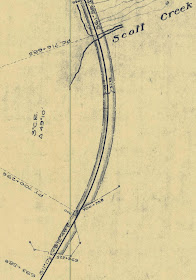 |
| Right-of-way near Scott Creek according to an Ocean Shore Railroad survey map from 1912. (UC Santa Cruz) |
Scott Creek and Scotts Valley are both named after Hiram Daniel Scott, a man from Maine who settled in Santa Cruz in 1846 and returned in 1852 after trying his luck in the gold mines and living in Stockton. In 1850, Scott purchase Joseph Ladd Major's Rancho San Agustín and Scott and his family moved into the property in 1852 to start a cattle business. His home in Scotts Valley still exists and is known as the "Scott House". In 1852, Scott also purchased a small portion of Rancho Agua Puerca y las Trancas on the North Coast, though it seems he never did much with this land. The lasting legacy of this tract of land was the creek that was named after him and the two Ocean Shore Railroad stops that lasted for less than two decades. Scott died in 1886 on a mining expedition in Arizona. When the Scott family relinquished the land is unknown.
 |
| Hiram Daniel Scott [Scotts Valley Historical Society] |
Scott Junction, on the other hand, was more of a fictional stop and a depressing one at that. It's location is not certain and there is little evidence that any switch was located at the site. From all records available to this historian, the tracks just continued through Scott Junction without the option of a formal end-of-track on the non-existent main line. The junction was located 13.4 miles north of Santa Cruz, a surprising 0.6 miles north of the fictional Scott community. There is no evidence of a siding, spur, or platform at Scott Junction, though photographs of the station sign are extant. From the junction, the tracks continued north on the east side of Scott Creek.
Scott and Scott Junction saw little service except for use as periodic freight stops and the occasional excursion stops. They were certainly closed as formal stops by 1920 when the Ocean Shore Railroad shut its doors, though both may well have closed earlier than that date. In all likelihood, Scott Junction was more of a reminder to passing trains that the railroad once aspired toward something greater. The tracks were removed in 1923 and centralized community ever developed near the mouth of Scott Creek. California State Route 1 follows mostly the same route as the Ocean Shore Railroad between Davenport and Scott Creek. The Swanton Berry Farm is in the general vicinity of Scott station today while the site of Scott Junction is near the place where Highway 1 crosses Molino Creek—the abandoned right-of-way is visible on satellite maps just west of the highway here. All of the property on the west bank of the right-of-way today is part of Scott Beach County Park, a popular surfing locale though swimming is not recommended.
Citations:
- Donald Clark, Santa Cruz County Place Names: A Geographical Dictionary (Scotts Valley, CA: Kestrel Press, 2007).

The actual location of Scott Junction is just a few feet to the west of Highway 1 and buried
ReplyDeleteunder a few feet of sand about halfway between Molino and Scott Creeks. It is north from here
you can barely see a very short stretch of roadbed parallel to the west side of Highway 1
which was once intended to carry passengers to San Francisco. East, across Highway 1 from
Scott Junction, you will find a private ranch road which was the original right of way of
the Swanton branch. It gently curves downward to the valley where the site of Folger
was located, a long row of utility poles and eventually Swanton. South of Scott Junction
are the remains of the fill which crossed Molino Creek followed by a very impressive
deep and wide cut the Ocean Shore ran through also to the west of Highway 1 running
south towards a merge with the present Highway 1 and on to Davenport.
.